
Calcutts Ironworks was an ironworks in Jackfield, in Shropshire, England. It was established in 1767, and production ceased in 1828. The works became an important producer of cannon.

Calcutts Ironworks was an ironworks in Jackfield, in Shropshire, England. It was established in 1767, and production ceased in 1828. The works became an important producer of cannon.
The site was on the River Severn, in Ironbridge Gorge about 1 mile (1.6 km) east of Ironbridge. The location is grid reference SJ 686 031 [1] ( 52°37′31″N2°27′53″W / 52.62528°N 2.46472°W ).
In 1767 George Matthews leased the site from Sir Onesiphorus Paul, and he built two furnaces, the bellows being operated by water wheels; the site produced pig iron. In 1778 Matthews was one of a partnership. [2]
By 1786, when the operators were Baille, Pocock and Co., the site had two blast furnaces, which could each produce 40 tons of iron a week, air furnaces, two bar iron forges and three steam engines. The site manufactured cannon. [2]
In that year the lease was bought by Alexander Brodie, a Scottish blacksmith from London. He closed the forge; in the foundry he produced mainly a ship's stove (his patent design) and cannon. By 1796 he was making 32-pounder cannon, and by about 1804 there were four furnaces. It was one of only three sites in the country with a steam-powered boring mill; cannons were bored eleven at a time. They were shipped to Bristol, for naval use. This was the period of the Napoleonic Wars; the site was visited by William V, Prince of Orange during a tour of Shropshire. [1] [2]
Brodie died in 1811, and his nephew, also Alexander Brodie, took over. By 1815 the works had fallen into disrepair. About 1817 the works was leased by William Hazledine, and he produced iron unprofitably for a few years. The last furnace was closed in 1828. He gave up the lease in 1831; the foundry was demolished in 1836. [2]
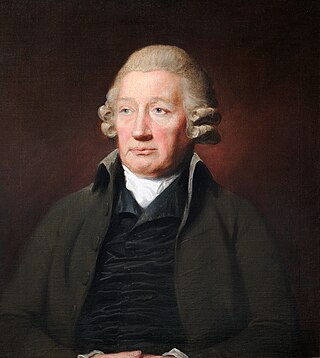
John "Iron-Mad" Wilkinson was an English industrialist who pioneered the manufacture of cast iron and the use of cast-iron goods during the Industrial Revolution. He was the inventor of a precision boring machine that could bore cast iron cylinders, such as cannon barrels and piston cylinders used in the steam engines of James Watt. His boring machine has been called the first machine tool. He also developed a blowing device for blast furnaces that allowed higher temperatures, increasing their efficiency, and helped sponsor the first iron bridge in Coalbrookdale. He is notable for his method of cannon boring, his techniques at casting iron and his work with the government of France to establish a cannon foundry.

Coalbrookdale is a town in the Ironbridge Gorge and the Telford and Wrekin borough of Shropshire, England, containing a settlement of great significance in the history of iron ore smelting. It lies within the civil parish called the Gorge.
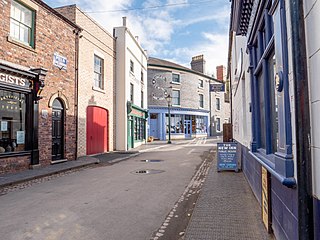
Blists Hill Victorian Town is an open-air museum built on a former industrial complex located in Madeley, Telford and Wrekin, Shropshire, England. The museum attempts to recreate the sights, sounds and smells of a Victorian Shropshire town in the late 19th and early 20th centuries. It is one of ten museums operated by the Ironbridge Gorge Museum Trust.
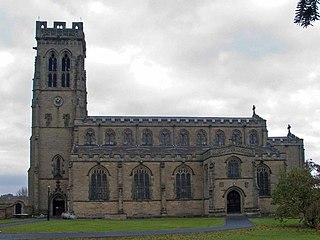
Broseley is a market town in Shropshire, England, with a population of 4,929 at the 2011 Census and an estimate of 5,022 in 2019. The River Severn flows to its north and east. The first iron bridge in the world was built in 1779 across the Severn, linking Broseley with Coalbrookdale and Madeley. This contributed to the early industrial development in the Ironbridge Gorge, which is now part of a World Heritage Site.

The Madeley Wood Company was formed in 1756 when the Madeley Wood Furnaces, also called Bedlam Furnaces, were built beside the River Severn, one mile west of Blists Hill.

James Foster was a prominent Worcestershire ironmaster, coalmaster and senior partner in the important iron company of John Bradley & Co, Stourbridge, which was founded by his elder half-brother but greatly enlarged under his direction. As well as the Stourbridge ironworks, the business owned a number of coal and ironstone mines, furnaces, forges and other works in the Black Country and near Ironbridge. The business continued long after James Foster's death, ultimately being incorporated as John Bradley (Stourbridge) Ltd in the early 20th century. In the late 19th century, the company was a member of the Marked Bar Association, whose members were the makers of the highest quality bar iron of the time. Foster was also a partner in other companies including the engineering firm Foster, Rastrick and Company, which built the first steam locomotive to run on rails in the USA. He was also a banker and landowner as well as being elected Member of Parliament and appointed as Improvement Commissioner for Stourbridge, and High Sheriff of Worcestershire.
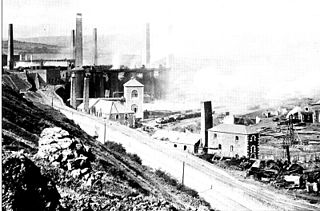
The Cyfarthfa Ironworks were major 18th- and 19th-century ironworks in Cyfarthfa, on the north-western edge of Merthyr Tydfil, in South West Wales.

Horsehay is a suburban village on the western outskirts of Dawley in the Telford and Wrekin borough of Shropshire, England. Horsehay lies in the Dawley Hamlets parish, and on the northern edge of the Ironbridge Gorge area.
Haigh Foundry was an ironworks and foundry in Haigh, Lancashire, which was notable for the manufacture of early steam locomotives.

Bersham Ironworks were large ironworks at Bersham, near Wrexham, Wales. They are most famous for being the original working site of John Wilkinson. They were also the first site in the world to use a new way of boring holes in cannon and steam engine cylinders.

The Shropshire Canal was a tub boat canal built to supply coal, ore and limestone to the industrial region of east Shropshire, England, that adjoined the River Severn at Coalbrookdale. It ran from a junction with the Donnington Wood Canal ascending the 316 yard long Wrockwardine Wood inclined plane to its summit level, it made a junction with the older Ketley Canal and at Southall Bank the Coalbrookdale (Horsehay) branch went to Brierly Hill above Coalbrookdale; the main line descended via the 600 yard long Windmill Incline and the 350 yard long Hay Inclined Plane to Coalport on the River Severn. The short section of the Shropshire Canal from the base of the Hay Inclined Plane to its junction with the River Severn is sometimes referred to as the Coalport Canal.
William Hazledine was an English ironmaster. Establishing large foundries, he was a pioneer in casting structural ironwork, most notably for canal aqueducts and early suspension bridges. Many of these projects were collaborations with Thomas Telford, including the Pontcysyllte Aqueduct and the Menai Suspension Bridge.
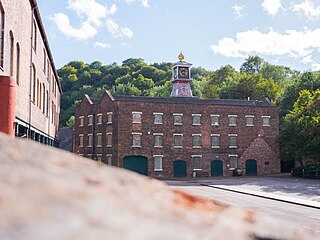
The Coalbrookdale Museum of Iron is one of ten Ironbridge Gorge Museums administered by the Ironbridge Gorge Museum Trust. The museum is based in the town of Coalbrookdale in the Ironbridge Gorge, in Shropshire, England, within a World Heritage Site, the birthplace of the Industrial Revolution.

Thomas Walmsley and Sons was a company that manufactured wrought iron. It was founded in 1866 or 1869 by Thomas Walmsley at the Atlas Forge on a site bounded by Bridgeman Street and Fletcher Street in Bolton, then in Lancashire, England. The forge had at least 16 puddling furnaces and forging and rolling mills.
Resolution was an early beam engine, installed between 1781 and 1782 at Coalbrookdale as a water-returning engine to power the blast furnaces and ironworks there. It was one of the last water-returning engines to be constructed, before the rotative beam engine made this type of engine obsolete.

The Low Moor Ironworks was a wrought iron foundry established in 1791 in the village of Low Moor about 3 miles (4.8 km) south of Bradford in Yorkshire, England. The works were built to exploit the high-quality iron ore and low-sulphur coal found in the area. Low Moor made wrought iron products from 1801 until 1957 for export around the world. At one time it was the largest ironworks in Yorkshire, a major complex of mines, piles of coal and ore, kilns, blast furnaces, forges and slag heaps connected by railway lines. The surrounding countryside was littered with waste, and smoke from the furnaces and machinery blackened the sky. Today Low Moor is still industrial, but the pollution has been mostly eliminated.

The Museum of the Gorge, originally the Severn Warehouse, is one of the ten museums of the Ironbridge Gorge Museum Trust. It portrays the history of the Ironbridge Gorge and the surrounding area of Coalbrookdale, Shropshire, England.

Richard Reynolds was an ironmaster, a partner in the ironworks in Coalbrookdale, Shropshire, at a significant time in the history of iron production. He was a Quaker and philanthropist.
Ketley Ironworks was an ironworks in Ketley, in Shropshire, England. Established in 1756, it was one of the largest ironworks in Britain during its ownership by William Reynolds and his brother Joseph.

Stirchley Chimney is a chimney located in Telford Town Park. The chimney also marks a notable waypoint on the South Telford Heritage Trail. Measuring 209 feet (64 m) high, construction of the chimney was completed in 1873.